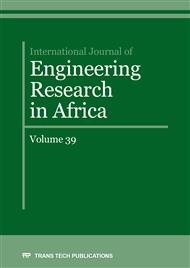[1]
J.A. Youngquist, A.M. Krzysik, E.W. English, H.N. Spelter and P. Chow, Agricultural fibres in composition panels. In: Proceedings of the 27th International particles board/composites materials symposium, Pullman, Washington: Washington State University, (1996).
Google Scholar
[2]
A.C. Johnson and Y.B.D.N. Yunus, Particleboards from Rice Husk: a brief introduction to Renewable materials of Construction, (2009) 12-14.
Google Scholar
[3]
B.S. Ndazi, J.V. Tesha, S. Karlsson and E.T.N. Bisanda, Production of rice husk composite with Acacia mimosa tannin-based resin. Journal of material science. 41(21) (2006) 6978-6983.
DOI: 10.1007/s10853-006-0220-7
Google Scholar
[4]
V. Laemlaksakul, Physical and mechanical properties of particleboard from Bamboo waste. International Journal of Chemical, Molecular, Nuclear, Materials and metallurgical Engineering, World Academy of Science, Engineering and Technology. 4(4) (2010).
Google Scholar
[5]
M. Rizki, Y. Tamai, Y. Takashi and M. Terazawa, Scrutiny on physical properties of sawdust from tropical commercial wood species: Effects of Different Mills and Sawdust's Particle Size. Journal of Forestry Research. 7(1) (2010) 20-23.
DOI: 10.20886/ijfr.2010.7.1.20-32
Google Scholar
[6]
O.M. Aina, A.C. Adetogun and K.A. Iyiola, Heat energy from value-added sawdust briquettes of albizia zygia, Ethiopian Journal of Environmental Studies and Management. 2(1) (2009).
DOI: 10.4314/ejesm.v2i1.43501
Google Scholar
[7]
X. Liu, X. Chen, L. Yang, H. Chen, Y. Tian and Z. Wang, A review on recent advances in the comprehensive application of rice husk ash. Research on Chemical Intermediates, (2016) 1-21.
DOI: 10.1007/s11164-015-2061-y
Google Scholar
[8]
V.I.E. Ajiwe, C.A. Okeke, S.C. Ekwuozor and I.C. Uba, A Pilot Plant for Production of Ceiling Boards from Rice Husks, Bioresource Technology. 66(1) (1998) 41-43.
DOI: 10.1016/s0960-8524(98)00023-6
Google Scholar
[9]
R.R. Melo, E.J. Santini, C.R. Haselein and D.M. Stangerlin, Propiedades fisico-mecanicas de paineis aglomerados produzidos con diferentes proporcoes de Madeira e casca de arroz. Ciencia Florestal, 19(4) (2009) 449-460.
DOI: 10.5902/19805098899
Google Scholar
[10]
T.E. Omoniyi, Development and Evaluation of Bagasse Reinforced Cement Composite Roofing Sheets. Unpublished Ph.D. Thesis, Department of Agricultural Engineering, University of Ibadan, (2009).
Google Scholar
[11]
H. Poblete, Tableros de partículas, Facultad de Ciencias Forestales, Universidad Austral de Chile. Editorial El Kultrún, Valdivia, Chile, (2001) p.177.
DOI: 10.4206/bosque.1981.v4n1-07
Google Scholar
[12]
R.R. Melo, D.M. Stangerlin, R.R.C. Santana and T.D. Pedrosa, Physical and Mechanical Properties of Particleboard Manufactured from Wood, Bamboo and Rice Husk, Material research. (2014).
DOI: 10.1590/s1516-14392014005000052
Google Scholar
[13]
American Society for Testing and Materials – ASTM. Standard testing methods for evaluating wood-base fibre and particle panel materials: specification ASTM D 1037-98. Philadephia: ASTM (1998).
Google Scholar
[14]
R.R. Melo and C.H.S. Del Menezzi, Influencia da massa especifica nas propiedades fisico-mecanicas de paineis aglomerados. Silva Lusitana. 18(1) (2010) 59-73.
Google Scholar
[15]
American National Standard Institute – ANSI. (1993) Mat-formed wood particleboard: Specification ANSI A 208.1.(1993).
Google Scholar
[16]
J.K. Odusote, S.A. Onowuma and E.A. Fodeke (2016). Production of paperboard briquette using waste paper and sawdust, The journal of engineering research (TJER). 13(1) (2010) 80-88.
DOI: 10.24200/tjer.vol13iss1pp80-88
Google Scholar
[17]
EN 312-2 - Particleboard-Specification - Part 4: Requirements for general purpose boards for use in dry conditions, European Standard Committee, Brussel. (1996).
Google Scholar
[18]
United State Department of Agriculture USDA – Wood Handbook: Wood as an engineering material, Washington, (2010) p.243.
Google Scholar
[19]
EN 312-3 - Particleboard-Specification - Part 3: Requirements for boards for interior fitments (including furniture) for use in dry conditions, European Standard Committee, Brussel. (1996).
DOI: 10.3403/00943162u
Google Scholar
[20]
J.O. Osarenmwinda and J.C. Nwachukwu, Effect of particle size on some properties of rice husk particleboard. Advanced Material Research, 18-19 (2007) 43-48.
DOI: 10.4028/www.scientific.net/amr.18-19.43
Google Scholar


